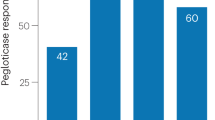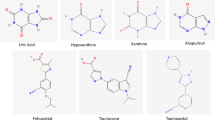Abstract
The prevalence of gout has increased markedly in the United States in the past two decades, and new treatments for hyperuricemia are being developed. Recent molecular identification of urate transporter-1 (URAT1) as the central mediator of renal urate reabsorption has provided novel understanding of the pathogenesis of hyperuricemia, and the target site for current and possibly future primary uricosuric agents. Recent studies have also highlighted uricosuric effects of several drugs (losartan, atorvastatin, fenofibrate) that are prescribed for primary indications other than hyperuricemia. The niche of these agents in current management of hyperuricemia is discussed. We also review the ongoing development of recombinant uricase preparations and of novel xanthine oxidase inhibitors exemplified by febuxostat. These agents should provide novel options for patients with chronic, refractory gout and hyperuricemia, particularly in association with allopurinol hypersensitivity and renal insufficiency.
Similar content being viewed by others
References and Recommended Reading
Terkeltaub RA: Gout. N Engl J Med 2003, 349:1647–1655. This comprehensive review provides evidence and clinical recommendations for the treatment of acute and chronic gout. This paper focuses on therapeutic agents that are currently approved and available for the treatment of gout.
Kim KY, Schumacher R, Hunsche E, et al.: A literature review of the epidemiology and treatment of acute gout. Clin Ther 2003, 25:1593–1617.
Bieber JD, Terkeltaub RA: Gout: on the brink of novel therapeutic options for an ancient disease. Arthritis Rheum 2004, 50:2400–2414. This is an excellent review of risk factors associated with gout and comments on potential etiologies for the rising prevalence of gout. This paper further discusses recent advances in translational research and their implications for the management options for gout.
Wallace KL, Riedel AA, Joseph-Ridge N, Wortmann R: Increasing prevalence of gout and hyperuricemia over 10 years among older adults in a managed care population. J Rheumatol 2004, 31:1582–1587.
Wu X, Wakamiya M, Vaishnav S, et al.: Hyperuricemia and urate nephropathy in urate oxidae-de.cient mice. Proc Natl Acad Sci U S A 1994, 91:742–746.
Yamanaka H, Togashi R, Hokoda M, et al.: Optimal range of serum urate concentrations to minimize risk of gouty attacks during anti-hyperuricemic treatment. Adv Exp Med Biol 1998, 431:13–18.
Abbott KC, Kimmel PL, Dharnidharka V, et al.: New-onset gout after kidney transplantation: incidence, risk factors and implications. Transplantation 2005, 80:1383–1391.
Anzai N, Enomoto A, Endou H: Renal urate handling: clinical relevance of recent advances. Curr Rheum Rep 2005, 7:227–234. This review summarizes recent molecular findings of urate transport and provides insights on how these new discoveries may contribute to the development of new uricosuric drugs.
Hediger MA, Johnson RJ, Miyazaki H, Endou H: Molecular physiology of urate transport. Physiology 2005, 20:125–133.
Enomoto A, Kimura H, Chairoungdua A, et al.: Molecular identification of a renal urate anion exchanger that regulates blood urate levels. Nature 2002, 417:447–452.
Rafey MA, Lipkowitz MS, Leal-Pinto E, Abramson RG: Uric acid transport. Curr Opin Nephrol Hypertens 2003, 12:511–516.
Ichida K, Hosoyamada M, Hisatome I, et al.: Clinical and molecular analysis of patients with renal hypouricemia in Japan-influence of URAT1 gene on urinary urate excretion. J Am Soc Nephrol 2004, 15:164–173.
Graessler J, Graessler A, Unger S, et al.: Association of the human urate transporter 1 with reduced renal uric acid excretion and hyperuricemia in a German Caucasian population. Arthritis Rheum 2006, 54:292–300.
Taniguchi A, Urano W, Yamanaka M, et al.: A common mutation in an organic anion transporter gene, SLC22A12, is a suppressing factor for the development of gout. Arthritis Rheum 2005, 52:2576–2577.
Choi HK, Liu S, Curhan G: Intake of purine-rich foods, protein, and dairy products and relationship to serum levels of uric acid. The Third National Health and Nutrition Examination Survey. Arthritis Rheum 2005, 52:283–239.
Dessein PH, Shipton EA, Stanwix AE, et al.: Beneficial effects of weight loss associated with moderate calorie/ carbohydrate restriction, and increased proportional intake of protein and unsaturated fat on serum urate and lipoprotein levels in gout: a pilot study. Ann Rheum Dis 2000, 59:539–543. This is the first paper assessing the impact of dietary modification on serum uric acid level and the frequency of gout flares. Unlike traditional dietary recommendations of low purine and protein intake, this study utilizes a low carbohydrate/high protein diet aimed at lowering insulin resistance to decrease the risk of gout.
Bardin T: Current management of gout in patients unresponsive or allergic to allopurinol. Joint Bone Spine 2004, 71:481–485.
Daskalopoulou SS, Tzovaras V, Mikhailidis DP, Elisaf M: Effect on serum uric acid levels of drugs prescribed for indications other than treating hyperuricaemia. Curr Pharm Des 2005, 11:4161–4175.
Sica DA, Schoolwerth AC: Part 1. Uric acid and losartan. Curr Opin Nephrol Hypertens 2002, 11:475–482.
Kamper Al, Nielsen AH: Uricosuric effect of losartan in patients with renal transplants. Transplantation 2001, 72:671–674.
Feher MD, Hepburn AL, Hogarth MB, et al.: Fenofibrate enhances urate reduction in men treated with allopurinol for hyperuricaemia and gout. Rheumatology 2003, 42:321–325.
Hepburn AL, Kaye SA, Feher MD: Long term remission from gout associated with fenofibrate therapy. Clin Rheumatol 2003, 22:73–76.
Lee Y, Lee J: Effect of fenofibrate in combination with urate lowering agents in patients with gout. Arthritis Rheum 2005, 52(Suppl 9):S104.
Rayner BL, Trinder YA, Baines D, et al.: Effect of losartan versus candesartan on uric acid, renal function, and fibrinogen in patients with hypertension and hyperuricemia associated with diuretics. Am J Hypertens 2006, 19:208–213. This paper highlights the uricosuric effect of losartan, independent of its angiotensin II receptor blockade.
Giral P, Bruckert E, Jacob N, et al.: Homocysteine and lipid lowering agents. A comparison between atorvastatin and fenofibrate in patients with mixed hyperlipidemia. Atherosclerosis 2001, 154:421–447.
Milionis HJ, Kakafika AI, Tsouli SG, et al.: Effects of statin treatment on uric acid homeostasis in patients with primary hyperlipidemia. Am Heart J 2004, 148:635–640. This is a randomized study designed to evaluate the effects of atorvastatin and simvastatin on uric acid homeostasis. In this trial, only atorvastatin was shown to significantly lower serum uric acid levels.
Kakafika A, Tsimihodimos V, Elisaf M: Effect of atorvastatin on serum uric acid levels. Atherosclerosis 2001, 158:255.
Athyros BG, Elisaf M, Papageorgious AA, et al.: Effect of statins versus untreated dyslipidemia on serum uric acid levels in patients with coronary heart disease: a subgroup analysis of GREek Ator vastain and Coronar y-heartdisease Evaluation (GREACE) study. Am J Kidney Dis 2004, 43:589–599.
Fouqueray P, Zeiller J: Potent and rapid uricosuric effect of single and repeated doses of EMD 336340 in healthy volunteers. Arthritis Rheum 2005, 52(Suppl 9):S101.
Gutierrez-Macias A, Lizarralde-Palacios E, Martinez- Odriozola P, Miguel-De la Villa F: Fatal allopurinol hypersensitivity syndrome after treatment of asymptomatic hyperuricaemia. Br Med J 2005, 331:623–624.
Borstad GC, Bryant LR, Abel MP, et al.: Colchicine for prophylaxis of acute.ares when initiating allopurinol for chronic gouty arthritis. J Rheumatol 2004, 31:2429–2432.
Hung SI, Chung WH, Liou LB, et al.: HLA-B*5801 allele as a genetic marker for severe cutaneous adverse reactions caused by allopurinol. Proc Natl Acad Sci U S A 2005, 102:4134–4139.
Fam AG, Dunne SM, Iazzetta J, Paton TW: Efficacy and safety of desensitization to allopurinol following cutaneous reactions. Arthritis Rheum 2001, 60:981–983.
Bessmertny O, Robitaille LM, Cairo MS: Rasburicase: a new approach for preventing and/or treating tumor lysis syndrome. Curr Pharm Des 2005, 11:4177–4185.
Yim BT, Sims-McCallum RP, Chong PH: Rasburicase for the treatment and prevention of hyperuricemia. Ann Pharmacother 2003, 37:1047–1054.
Moolenburgh JD, Reinder MK, Jansen TL: Rasburicase treatment in severe tophaceous gout: a novel therapeutic option. Clin Rheumatol 2005, In press.
Vogt B: Urate oxidase (rasburicase) for treatment of severe tophaceous gout. Nephrol Dial Transplant 2005, 20:431–433.
Phillips M, Hunt RE, Shergy WJ, Hernandez J: Urate-oxidase in the treatment of severe tophaceous gout with hyperuricemia refractory to high-dose allopurinol: case report and review. Arthritis Rheum 2000, 43:S401.
Yamanaka H, Togashi R, Hokoda M, et al.: Optimal range of serum urate concentrations to minimize risk of gouty attacks during anti-hyperuricemic treatment. Adv Exp Med Biol 1998, 431:13–18.
Ganson NJ, Kelly SJ, Scarlett E, et al.: Control of hyperuricemia in subjects with refractory gout, and induction of antibody against poly(ethylene) glycol (PEG), in a phase I trial of subcutaneous PEGylated urate oxidase. Arthritis Res Ther 2006, In press. This article provides the safety and pharmacokinetic results of the initial phase I trial of PEG-uricase for patients with refractory gout.
Sundy J, Becker M, Baraf H, et al.: A Phase 2 study of multiple doses of intravenous polyethylene glycol (PEG)-uricase in patients with hyperuricemia and refractory gout. Arthritis Rheum 2005, 52(Suppl 9):S679-S680.
Baraf H, Kim S, Matsumoto A, et al.: Resolution of tophi with intravenous Peg-uricase in refractory gout. Arthritis Rheum 2005, 52(Suppl 9):S105.
Becker MA, Schumacher Jr HR, Wortmann RL, et al.: Febuxostat, a novel non-purine selective inhibitor of xanthine oxidase. Arthritis Rheum 2005, 52:916–923.
Schumacher H, Becker M, Wortmann R, et al.: Febuxostat vs allopurinol and placebo in subjects with hyperuricemia and gout: the 28-week APEX study. Arthritis Rheum 2005, 52(Suppl 9):S680.
Becker M, Schumacher H, Wortmann R, et al.: Reduction in gout flares in subjects with chronic gout treated with febuxostat or allopurinol for 52-weeks: FACT trial. Arthritis Rheum 2005, 52(Suppl 9):S108.
Becker MA, Schumacher Jr HR, Wortmann RL, et al.: Febuxostat compared with allopurinol in patients with hyperuricemia and gout. N Engl J Med 2005, 353:2450–2461. This article provides the latest and the longest follow-up phase III clinical trial data on the safety and efficacy of febuxostat compared to allopurinol in patients with gout and hyperuricemia.
Wortmann R, Schumacher H, Becker M, et al.: Reduction in tophus size in subjects with chronic gout treated with febuxostat or allopurinol for 52 Weeks-FACT trial. Arthritis Rheum 2005, 52(Suppl 9):S108.
Sarawate C, Patel P, Brewer K, et al.: Impact of serum uric acid on risk of acute gout attacks. Arthritis Rheum 2005, 52(Suppl 9):S106.
Osterhaus JT, Patel P, Palo WA, et al.: Patient reported outcomes associated with gout: baseline results from two clinical trials. Arthritis Rheum 2005, 52(Suppl 9):S401-S402.
Baker JF, Krishnan E, Chen L, Schumacher HR: Serum uric acid and cardiovascular disease: recent developments, and where do they leave us? Am J Med 2005, 118:816–826. This article provides systemic review of recent studies conducted to evaluate the role of hyperuricemia in the development of cardiovascular disease.
Niskanen LK, Laaksonen DE, Nyyssonen K, et al.: Uric acid level as a risk factor for cardiovascular and all-cause mortality in middle-aged men: a prospective cohort study. Arch Intern Med 2004, 164:1546–1551.
Author information
Authors and Affiliations
Corresponding author
Rights and permissions
About this article
Cite this article
Lee, S.J., Terkeltaub, R.A. New developments in clinically relevant mechanisms and treatment of hyperuricemia. Curr Rheumatol Rep 8, 224–230 (2006). https://doi.org/10.1007/s11926-996-0029-z
Issue Date:
DOI: https://doi.org/10.1007/s11926-996-0029-z




